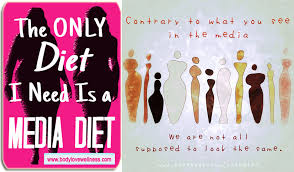Continuing on with our blog series on How to Help Your Adolescent Develop a Positive Body Image, Smarty Expert, Ann Kreindler-Siegel, LCSW, MSW, MAEd, SEP, talks to us today about HOW TO HELP YOUR ADOLESCENT BECOME A CRITICAL THINKER ABOUT THE MEDIA. Catch up on Ann’s first two features in this series, HOW TO HELP YOUR ADOLESCENT DEVELOP A POSITIVE BODY IMAGE, and THE DO’S & DON’TS FOR PARENTS OF CHILDREN & TEENS:
How can you help your children and teenagers take pride in who they are and how they look with all the messages they are bombarded by in today’s social media? These messages come from magazines, books, television, radio, the Internet and smartphones. Sites such is Instagram, Twitter and Facebook are filled with messages about body size and weight. Not only are celebrities and models exhibiting idealized images of body perfection, their friends and others their age are posting pictures of themselves and blogging about how they want to look and their ideal, which also affects one’s view of one’s own body size. Children and teens are hungry for advice on how to look and how to achieve what others’ view of ideal body size is.
Parents are in a powerful position of helping their kids counteract media messages by setting a positive environment at home of unconditional love and acceptance and an emphasis on who their children and teens are instead of what they look like. The Do’s and Don’ts written in the last article by this author provide a solid base to start with. In addition here are some Do’s and Don’ts to help counteract media messages to our children and teens about body image.
1. Focus on peoples’ qualities and traits not what they look like. Never mention a person’s size or weight as a factor in who they are or what you notice about them. Teach your children and teens to see beauty as coming from the inside of a person not the outside. You can have an enormous impact on your son or daughter’s views of themselves by keeping the lines of communication open and addressing their myths about body size and shape.
2. Provide “real” messages about how the media portrays celebrities, models and people in general. Many advertisements and articles are about weight loss, dieting and tips on how to change our bodies, size, shape and overall appearance. Educate your children and teens on how many photos of people in magazines and other media sources are airbrushed or distorted in some way and the sacrifices that many make to look a certain way.
3. Teach your children and teens that bodies come in different shapes and sizes. There are many resources available to help educate your children and teens on the real story of how bodies look and what is reality. Two of this author’s favorite books are Real Gorgeous by Kaz Cooke (available on Amazon) and No Body’s Perfect, by Kimberly Kirberger (available on half.com). Help your child and teen understand that no two people have the same body structure and shed a positive light on the diversity and variety that makes people unique and special in their own right. Teach them not to change how they look but rather to embrace who they are and how they look and emphasize one’s body as the vehicle to living one’s life. Equate the gas needed to fuel a car to the food needed to run their body and help them understand that calories are just a unit of energy that provide the fuel we need to live the lives we desire.
4. Engage your children and teens in family activities and decrease the exposure to unhealthy media. Though we all know that our children and teens are going to view many of the messages portrayed by media regularly, there are ways to decrease their exposure without being critical. Play board games as a family or talk about life issues. Communicate about issues your children and teens are dealing with, such as bullying, teasing, difficulties in relationships and friendships and help them learn that these issues are a normal part of growing up.
5. Provide a variety of media to your children and teens and talk about what their peers believe about body image and body size. Unconditional love and acceptance without criticism and judgement are probably the most important thing to provide as parents and significant others. We allow our children and teens to talk to us more if they know that their conversations will not be met with criticism or judgement. Always provide a positive role model in how you talk about your own body, size and weight and a positive view of who you are based on your qualities and self confidence rather than your looks. Teach your children and teens to have a voice not hide what they have to say so that they can speak up for themselves. After all, if they don’t learn to “talk back” how will you converse with them as they get older?
Tune in next Friday as Ann gives her tips on WARNING SIGNS THAT YOUR CHILD OR TEEN MIGHT BE STRUGGLING WITH AN EATING DISORDER…
Ann Kreindler-Siegel, LCSW, MSW, MAEd, SEP is a Licensed Clinical Social worker in private practice in Charlotte, NC in the SouthPark area and has a dual Master’s degrees in Social Work and Counseling from Washington University in St. Louis, Missouri. During her career as a therapist, in addition to her specialization in treating people with Eating Disorders and trauma, she has also worked with numerous individuals and couples who have divorced, or are currently divorcing. Ann also teaches parenting workshops and works with many adolescents whose parents are divorced. She has worked in this field for 35 years and is trained in all modalities of therapy. Her most recent training is as a Somatic Experiencing Practitioner and she has received her SEP certification in 2010. Somatic Experiencing is Ann’s primary modality of practice mixed with psychodynamic, family systems and cognitive behavioral counseling techniques.
After earning the Certificate in Executive Coaching from Queens University in Charlotte, North Carolina, Ann achieved credentialing as a Board Certified Coach (BCC) and a Collaborative Divorce Coach.
As a Collaborative Divorce Coach and licensed and trained mental health professional, Ann can be a valuable resource to divorcing couples. She can assist individuals and families in crafting parenting plans and the negotiations of their lives going forward, as well as settling anxieties that are common during separation and divorce.
Somatic Experiencing techniques are aimed at settling the nervous system and allow smoother transitions and a gentler style of collaboration. Ann continues to work as a therapist in private practice and has added coaching to her career to assist individuals and families to create their best lives going forward. In addition, she has spoken on numerous topics nationally and internationally on Somatic Experiencing, Eating Disorders, parenting, attachment, shame, and coaching.
You can find Ann at www.gently-transition.com.





